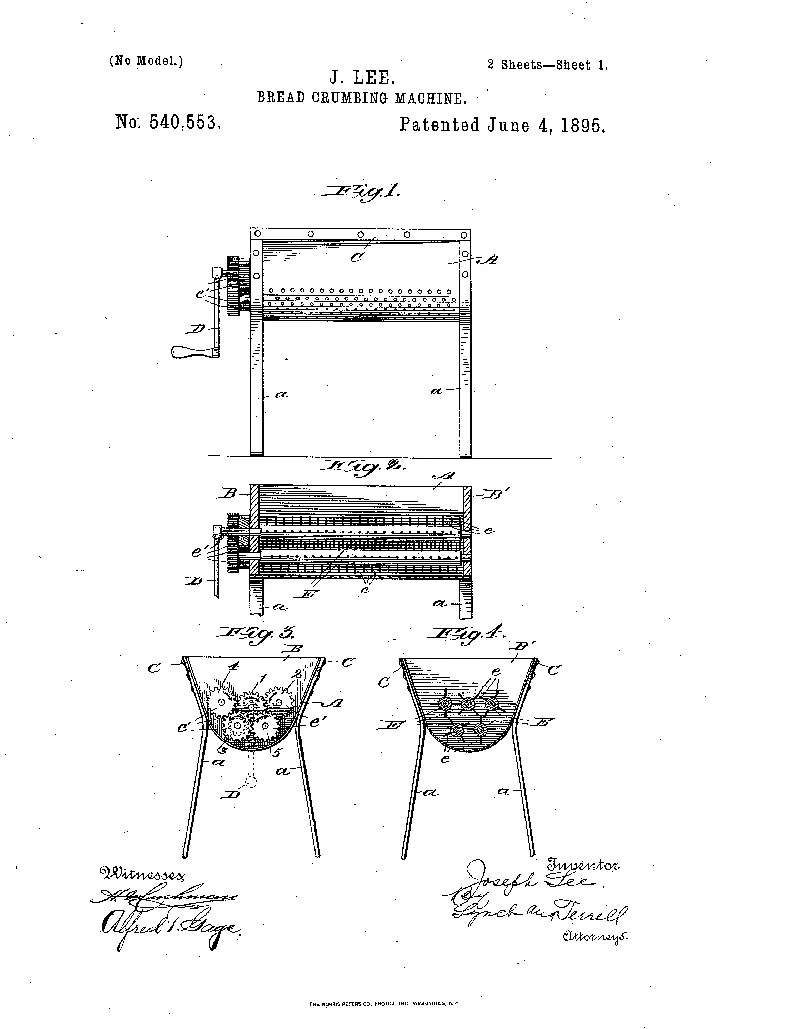The National Inventors Hall of Fame Announces Its 2019 Inductees
Joseph Lee, inventor of the automatic bread and breadcrumb makers, was posthumously honored alongside 18 other men and women
/https://tf-cmsv2-smithsonianmag-media.s3.amazonaws.com/filer/75/61/7561151d-b050-4b98-a432-67c2a305db03/screen_shot_2019-01-09_at_105357_am.png)
On Tuesday, the National Inventors Hall of Fame (NIHF) announced its 2019 inductees, an impressive group of 19 innovators whose contributions to the world include a web browser optimized for the blind and visually impaired, the portable hand-held electric drill, and the humble bread and breadcrumb makers.
The man behind this last pair of inventions—a Boston entrepreneur named Joseph Lee—drew inspiration from his many years in the hospitality industry. Born the son of slaves in 1849, he spent his childhood working in a bakery. Following an 11-year stint as a steward in the U.S. Coast Survey, the then-burgeoning chef opened his own business, making a name for himself as a successful hotel and restaurant owner.
Lee received his first patent in August 1894. Dubbed a “kneading machine,” the device aimed to automate the bread-making process by enabling the production of uniform loaves. As Lee noted in the patent, the invention was designed to “thoroughly mix and knead the dough and bring it to the desired condition without resorting to the tedious process of mixing and kneading the same by hand,” yielding dough “of a superior quality and fineness.”
Ingeniously, Lee’s kneading machine relied on “two oppositely revolving conveyers” to ensure that dough was “continually thrown to the center to receive the kneading action of the pestles,” or rounded crushing and grinding tools. Today’s automatic bread makers utilize a similar mechanism, with dough typically being evenly kneaded by swirling paddles.
Gaius Chamberlain of the Black Inventor Online Museum writes that the bread maker was capable of performing the tasks of five or six workers with not only higher hygiene standards, but also at a significantly cheaper cost.
According to the NIHF website, Lee’s second invention also strove toward increased efficiency: After observing the high amount of unsold bread—often just a day or so old—discarded by restaurants on a daily basis, he sought to repurpose these slightly stale loaves as breadcrumbs.
In June 1895, Lee received a patent for his “bread crumbing machine,” outlining a goal of “a great saving in establishments where the bread waste from the table is considerable.” Although designed mainly for use in large-scale establishments such as hotels and restaurants, Lee explained that the device could also be used by private individuals seeking to sustainably discard of unused bread. To accomplish this task, the machine “seized” bread with its “tearing fingers,” pulling pieces in and crumbling them until the necessary level of fineness was achieved.

Prior to the invention of this crumbing device, cracker crumbs were often used to coat various foods. But as the African American Registry’s website reports, Lee’s pioneering tool pushed him and other chefs to substitute breadcrumb coatings on dishes ranging from croquettes to fried fish. Soon after he was granted his patent, Lee sold the rights to Boston’s Royal Worcester Bread Company, enabling the technology to spread to kitchens around the world.
By the time of Lee’s death in 1905, his devices were fixtures in leading food establishments across America. But over the following century, his name was largely forgotten. Now, thanks to the posthumous honor bestowed by the NIHF, as well as a 2011 book on the inventor’s life, and, of course, the countless bread and bread crumb makers still in use today, his indelible contributions to the food industry live on.
In addition to Lee, the NIHF’s class of 2019 inductees includes 18 inventors representing 11 different creations. According to Engadget, the living honorees are Chieko Asakawa, inventor of the first voice-activated web browser for the blind and visually impaired; Jeff Kodosky and James Truchard, inventors of the graphical programming language LabVIEW; Rebecca Richards-Kortum, creator of low-cost, high-performance medical technology offered to those unable to access traditional medical equipment; Ken Thompson, co-creator of the UNIX operating system; Edmund O. Schweitzer III, inventor of the first microprocessor-based digital protective relay; David Walt, creator of microwell arrays capable of analyzing thousands of genes at the same time; and William Warner, inventor of the digital nonlinear editing system Avid Media Composer.
Posthumously honored inventors include Lee; UNIX co-creator Dennis Ritchie; thiazide diuretic pioneers John Baer, Karl H. Beyer Jr., Frederick Novello and James Sprague; hand-held electric drill inventors Duncan Black and Alonzo G. Decker of the popular Black & Decker power tool company; Andrew Higgins, the mastermind behind the Higgins Boats used by American troops landing at Normandy on D-Day; and Joseph Muhler and William Nebergall, creators of the cavity-preventing stannous fluoride toothpaste better known today by the brand name Crest.
The inductees will be honored at the 47th Annual National Inventors Hall of Fame Induction Ceremony on May 2, 2019 at the National Building Museum in Washington, D.C.
/https://tf-cmsv2-smithsonianmag-media.s3.amazonaws.com/accounts/headshot/mellon.png)


/https://tf-cmsv2-smithsonianmag-media.s3.amazonaws.com/accounts/headshot/mellon.png)